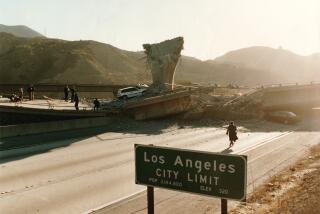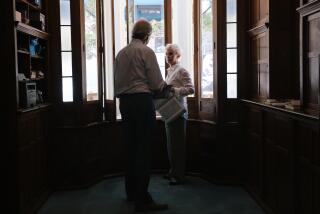Light Shed on Destruction of Old Church
- Share via
When the great earthquake of Dec. 8, 1812, wracked portions of Southern California, it spared the exquisite Serra Chapel, the soldiers’ barracks and other buildings on the grounds of Mission San Juan Capistrano.
But the bell tower and other portions of what came to be called the Old Stone Church, just a few yards away from the structures that were spared, collapsed and killed 40 parishioners attending a 7 a.m. Mass.
On Monday, an archeologist said he and his helpers believe they have found one reason the power of the temblor was concentrated so fatally in such a small area.
Nicholas Magalousis, director of the Mission Museum and archeological research director at Chapman College, said it “appears a small weak place” in some stone and mortar work could have been responsible.
“We found this weak spot in the old cut stone and mortar pavement (near what was the main entrance to the Old Stone Church), and the pavement could have buckled there during the quake,” he said, “pushing upward under the foundation of the bell tower.”
He said the tower probably was 100 feet tall, built of the same limestone, mortar and a material called silk stone as the standing remains of the altar portion of the old mission ruins. It might have been a little top-heavy with its big bells.
By Monday, the weak spot had been exposed as an approximately two-square-foot area thrusting about 10 centimeters above the adjacent paving, as workers carefully dusted away debris. It was discovered while Magalousis and his aides were beginning an effort to locate the true foundations of the old bell tower.
Dolores Schiffert, senior field assistant from Cypress College, said there has always been some disagreement as to whether the tower once stood directly in front of the church’s main entrance or slightly to the right side. She said old paintings and photographs show conflicting locations.
Discovery of the small area of faulty paving, the archeologists said, does not pinpoint the site of the bell tower foundation, which could have extended many feet in either direction.
Schiffert is working with brushes and other delicate tools several yards away from the faulty area. She is hoping to determine the depth of the foundation masonry work there, on the theory that the deeper the foundation, the more likely it was made that way to support the weight of a bell tower rather than an ordinary wall.
Magalousis, with archeological students from various colleges, has done extensive digging among the mission ruins in recent years. He said he hopes the present project will help determine the location of the bell tower and contribute to knowledge of both Spanish and Indian construction methods and quality of workmanship in those early days.
HISTORY OF MISSION SAN JUAN CAPISTRANO
Nov. 1, 1776--Escorted by 11 soldiers, the Rev. Junipero Serra recovers mission bells previously buried at site for safekeeping.
1778-1783--Father Serra conducts services in Serra’s Chapel, the oldest structure still standing in California.
1806--The Great Stone Church (later known as the Old Stone Church) is dedicated.
Dec. 8, 1812--During 7 a.m. Mass marking Feast of Immaculate Conception, earthquake topples bell tower, killing 40 Indian worshipers.
1821--Mexico confiscates mission from Roman Catholic Church, frees Indians.
1865--President Abraham Lincoln returns the mission to the Catholic Church.
1910-1933--Major restoration is led by Msgr. John O’Sullivan.
1936--A live radio broadcast of the swallows’ arrival spreads the mission’s fame.
1985--An architectural reproduction of the Old Stone Church is completed with a new, 103-foot bell tower.
More to Read
Sign up for Essential California
The most important California stories and recommendations in your inbox every morning.
You may occasionally receive promotional content from the Los Angeles Times.










